University Management Accounting Report: Cancer Charity Analysis
VerifiedAdded on 2022/08/25
|14
|3066
|47
Report
AI Summary
This report develops a balanced scorecard for a small cancer charity, designed to assist trustees in monitoring performance monthly. The scorecard encompasses four key perspectives: financial, customer, internal business processes, and learning and growth. Each perspective includes five measurable indicators. The financial perspective assesses fund-raising, donor numbers, budget increases, cost reductions, and average cost per patient. The customer perspective focuses on patient complaints, satisfaction, absenteeism, personalized services, and retention rates. The internal business process perspective evaluates consultation scheduling, new cases, treatment adherence, consultation sessions, and volunteer development. Finally, the learning and growth perspective considers training hours, learning program scores, staff turnover, and training program numbers. The report provides a comprehensive framework for evaluating and improving the charity's operational efficiency and effectiveness.
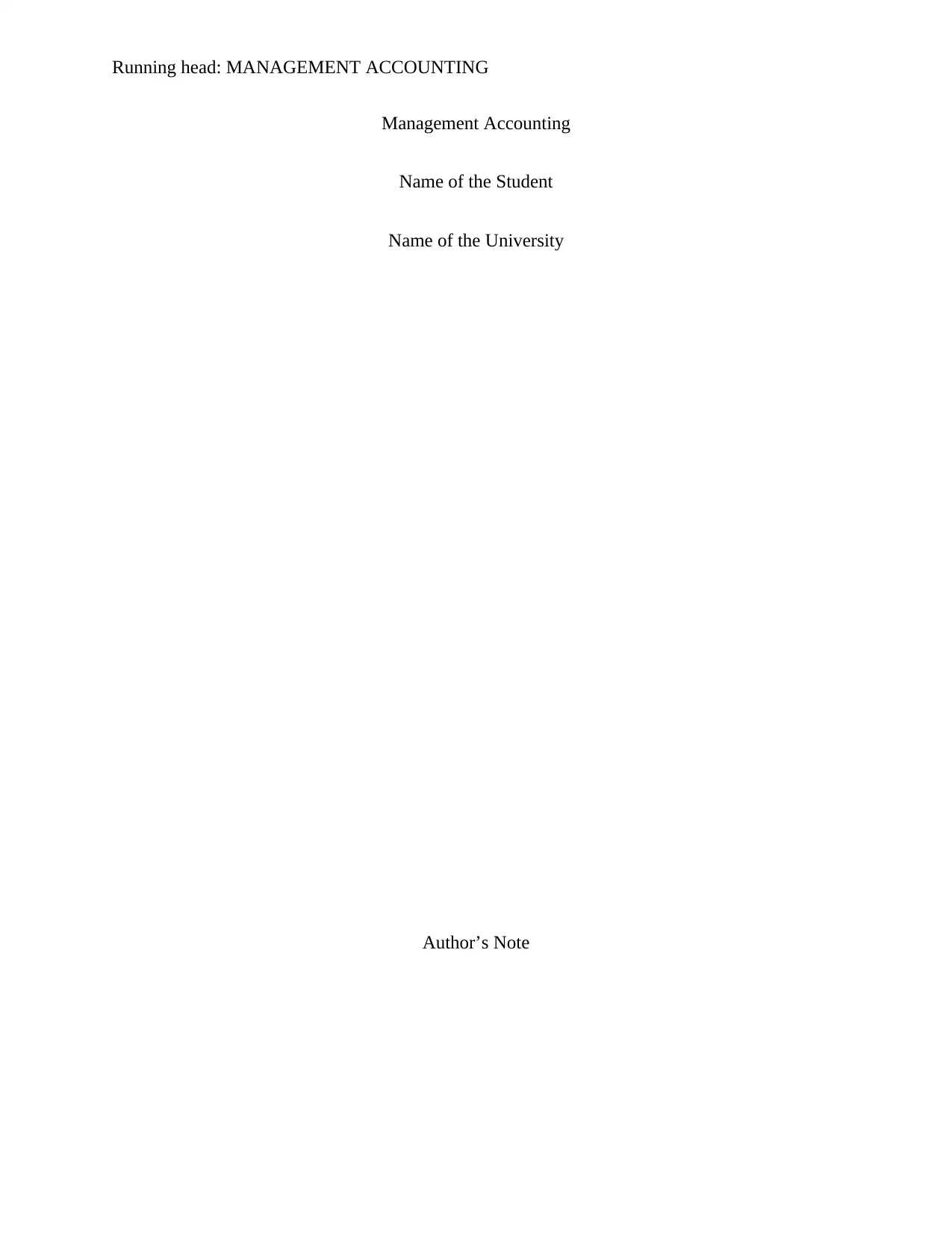
Running head: MANAGEMENT ACCOUNTING
Management Accounting
Name of the Student
Name of the University
Author’s Note
Management Accounting
Name of the Student
Name of the University
Author’s Note
Paraphrase This Document
Need a fresh take? Get an instant paraphrase of this document with our AI Paraphraser
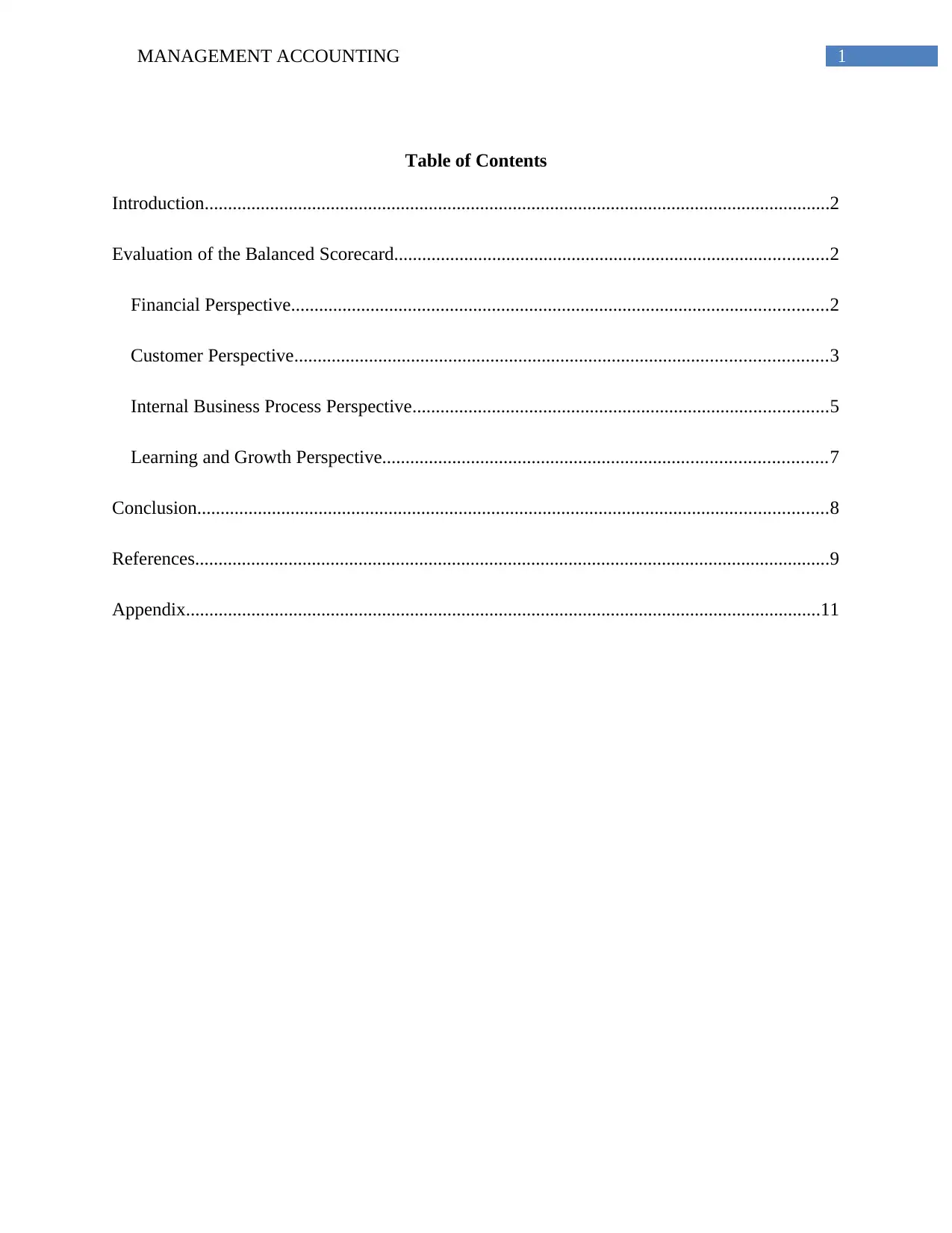
1MANAGEMENT ACCOUNTING
Table of Contents
Introduction......................................................................................................................................2
Evaluation of the Balanced Scorecard.............................................................................................2
Financial Perspective...................................................................................................................2
Customer Perspective..................................................................................................................3
Internal Business Process Perspective.........................................................................................5
Learning and Growth Perspective...............................................................................................7
Conclusion.......................................................................................................................................8
References........................................................................................................................................9
Appendix........................................................................................................................................11
Table of Contents
Introduction......................................................................................................................................2
Evaluation of the Balanced Scorecard.............................................................................................2
Financial Perspective...................................................................................................................2
Customer Perspective..................................................................................................................3
Internal Business Process Perspective.........................................................................................5
Learning and Growth Perspective...............................................................................................7
Conclusion.......................................................................................................................................8
References........................................................................................................................................9
Appendix........................................................................................................................................11
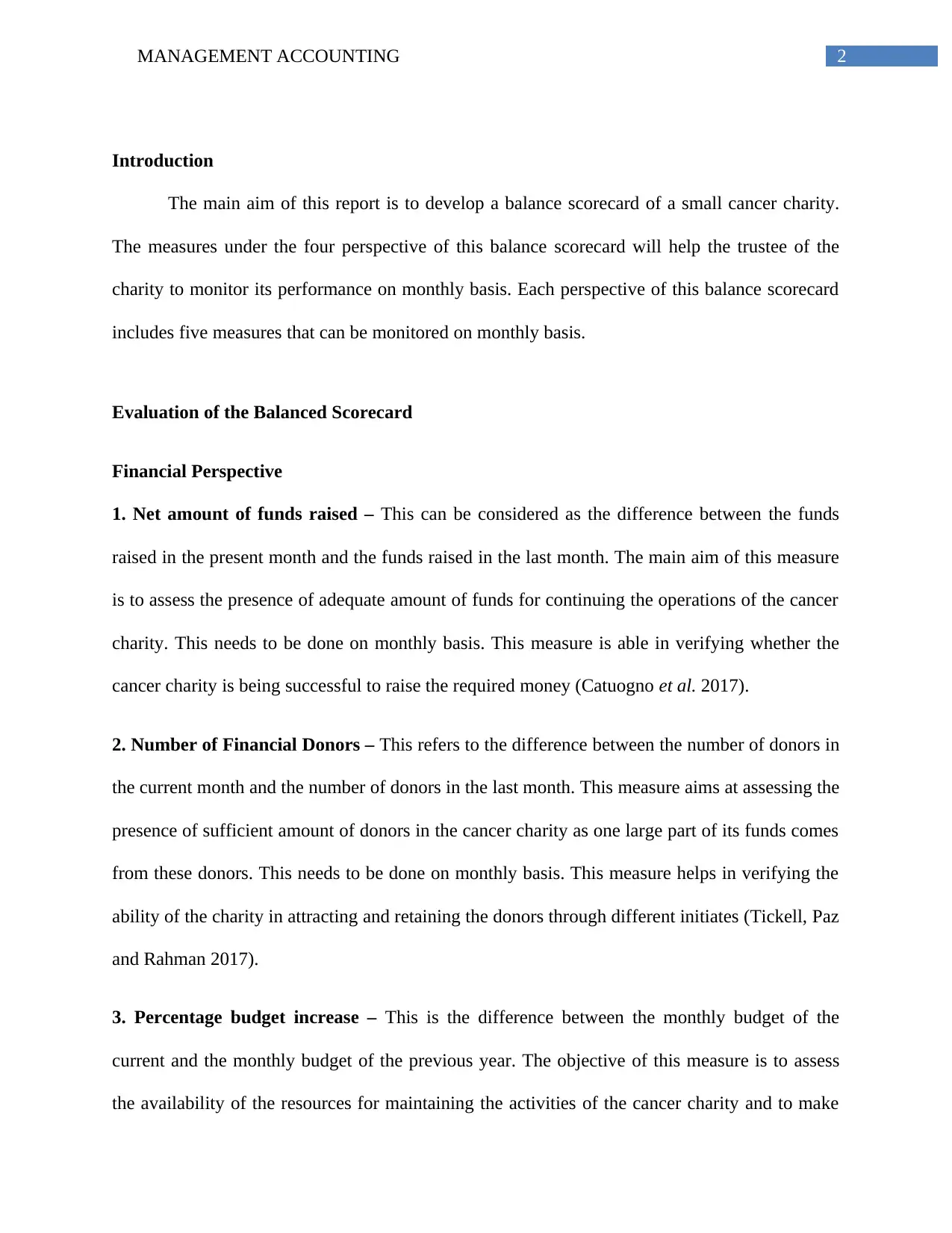
2MANAGEMENT ACCOUNTING
Introduction
The main aim of this report is to develop a balance scorecard of a small cancer charity.
The measures under the four perspective of this balance scorecard will help the trustee of the
charity to monitor its performance on monthly basis. Each perspective of this balance scorecard
includes five measures that can be monitored on monthly basis.
Evaluation of the Balanced Scorecard
Financial Perspective
1. Net amount of funds raised – This can be considered as the difference between the funds
raised in the present month and the funds raised in the last month. The main aim of this measure
is to assess the presence of adequate amount of funds for continuing the operations of the cancer
charity. This needs to be done on monthly basis. This measure is able in verifying whether the
cancer charity is being successful to raise the required money (Catuogno et al. 2017).
2. Number of Financial Donors – This refers to the difference between the number of donors in
the current month and the number of donors in the last month. This measure aims at assessing the
presence of sufficient amount of donors in the cancer charity as one large part of its funds comes
from these donors. This needs to be done on monthly basis. This measure helps in verifying the
ability of the charity in attracting and retaining the donors through different initiates (Tickell, Paz
and Rahman 2017).
3. Percentage budget increase – This is the difference between the monthly budget of the
current and the monthly budget of the previous year. The objective of this measure is to assess
the availability of the resources for maintaining the activities of the cancer charity and to make
Introduction
The main aim of this report is to develop a balance scorecard of a small cancer charity.
The measures under the four perspective of this balance scorecard will help the trustee of the
charity to monitor its performance on monthly basis. Each perspective of this balance scorecard
includes five measures that can be monitored on monthly basis.
Evaluation of the Balanced Scorecard
Financial Perspective
1. Net amount of funds raised – This can be considered as the difference between the funds
raised in the present month and the funds raised in the last month. The main aim of this measure
is to assess the presence of adequate amount of funds for continuing the operations of the cancer
charity. This needs to be done on monthly basis. This measure is able in verifying whether the
cancer charity is being successful to raise the required money (Catuogno et al. 2017).
2. Number of Financial Donors – This refers to the difference between the number of donors in
the current month and the number of donors in the last month. This measure aims at assessing the
presence of sufficient amount of donors in the cancer charity as one large part of its funds comes
from these donors. This needs to be done on monthly basis. This measure helps in verifying the
ability of the charity in attracting and retaining the donors through different initiates (Tickell, Paz
and Rahman 2017).
3. Percentage budget increase – This is the difference between the monthly budget of the
current and the monthly budget of the previous year. The objective of this measure is to assess
the availability of the resources for maintaining the activities of the cancer charity and to make
⊘ This is a preview!⊘
Do you want full access?
Subscribe today to unlock all pages.

Trusted by 1+ million students worldwide
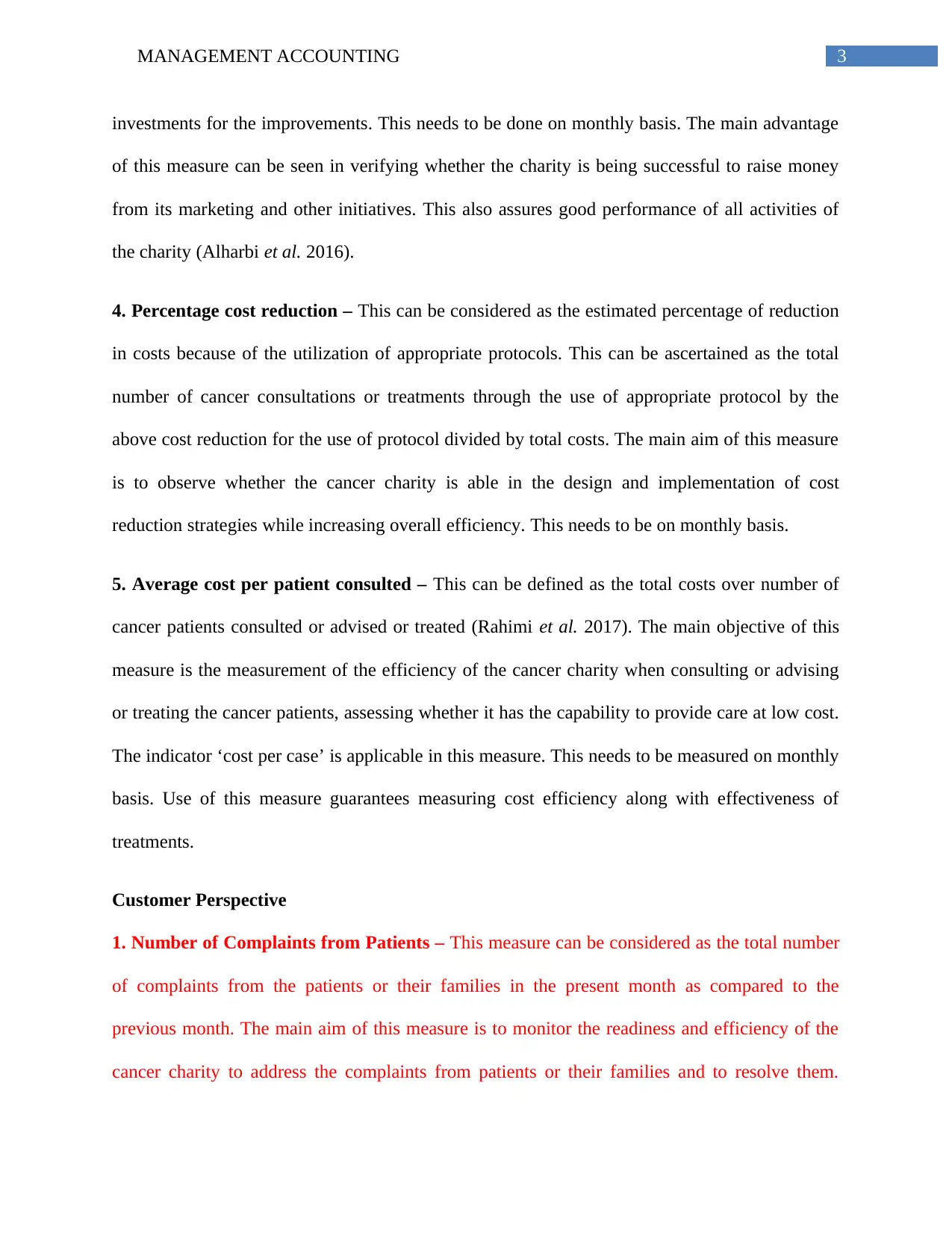
3MANAGEMENT ACCOUNTING
investments for the improvements. This needs to be done on monthly basis. The main advantage
of this measure can be seen in verifying whether the charity is being successful to raise money
from its marketing and other initiatives. This also assures good performance of all activities of
the charity (Alharbi et al. 2016).
4. Percentage cost reduction – This can be considered as the estimated percentage of reduction
in costs because of the utilization of appropriate protocols. This can be ascertained as the total
number of cancer consultations or treatments through the use of appropriate protocol by the
above cost reduction for the use of protocol divided by total costs. The main aim of this measure
is to observe whether the cancer charity is able in the design and implementation of cost
reduction strategies while increasing overall efficiency. This needs to be on monthly basis.
5. Average cost per patient consulted – This can be defined as the total costs over number of
cancer patients consulted or advised or treated (Rahimi et al. 2017). The main objective of this
measure is the measurement of the efficiency of the cancer charity when consulting or advising
or treating the cancer patients, assessing whether it has the capability to provide care at low cost.
The indicator ‘cost per case’ is applicable in this measure. This needs to be measured on monthly
basis. Use of this measure guarantees measuring cost efficiency along with effectiveness of
treatments.
Customer Perspective
1. Number of Complaints from Patients – This measure can be considered as the total number
of complaints from the patients or their families in the present month as compared to the
previous month. The main aim of this measure is to monitor the readiness and efficiency of the
cancer charity to address the complaints from patients or their families and to resolve them.
investments for the improvements. This needs to be done on monthly basis. The main advantage
of this measure can be seen in verifying whether the charity is being successful to raise money
from its marketing and other initiatives. This also assures good performance of all activities of
the charity (Alharbi et al. 2016).
4. Percentage cost reduction – This can be considered as the estimated percentage of reduction
in costs because of the utilization of appropriate protocols. This can be ascertained as the total
number of cancer consultations or treatments through the use of appropriate protocol by the
above cost reduction for the use of protocol divided by total costs. The main aim of this measure
is to observe whether the cancer charity is able in the design and implementation of cost
reduction strategies while increasing overall efficiency. This needs to be on monthly basis.
5. Average cost per patient consulted – This can be defined as the total costs over number of
cancer patients consulted or advised or treated (Rahimi et al. 2017). The main objective of this
measure is the measurement of the efficiency of the cancer charity when consulting or advising
or treating the cancer patients, assessing whether it has the capability to provide care at low cost.
The indicator ‘cost per case’ is applicable in this measure. This needs to be measured on monthly
basis. Use of this measure guarantees measuring cost efficiency along with effectiveness of
treatments.
Customer Perspective
1. Number of Complaints from Patients – This measure can be considered as the total number
of complaints from the patients or their families in the present month as compared to the
previous month. The main aim of this measure is to monitor the readiness and efficiency of the
cancer charity to address the complaints from patients or their families and to resolve them.
Paraphrase This Document
Need a fresh take? Get an instant paraphrase of this document with our AI Paraphraser
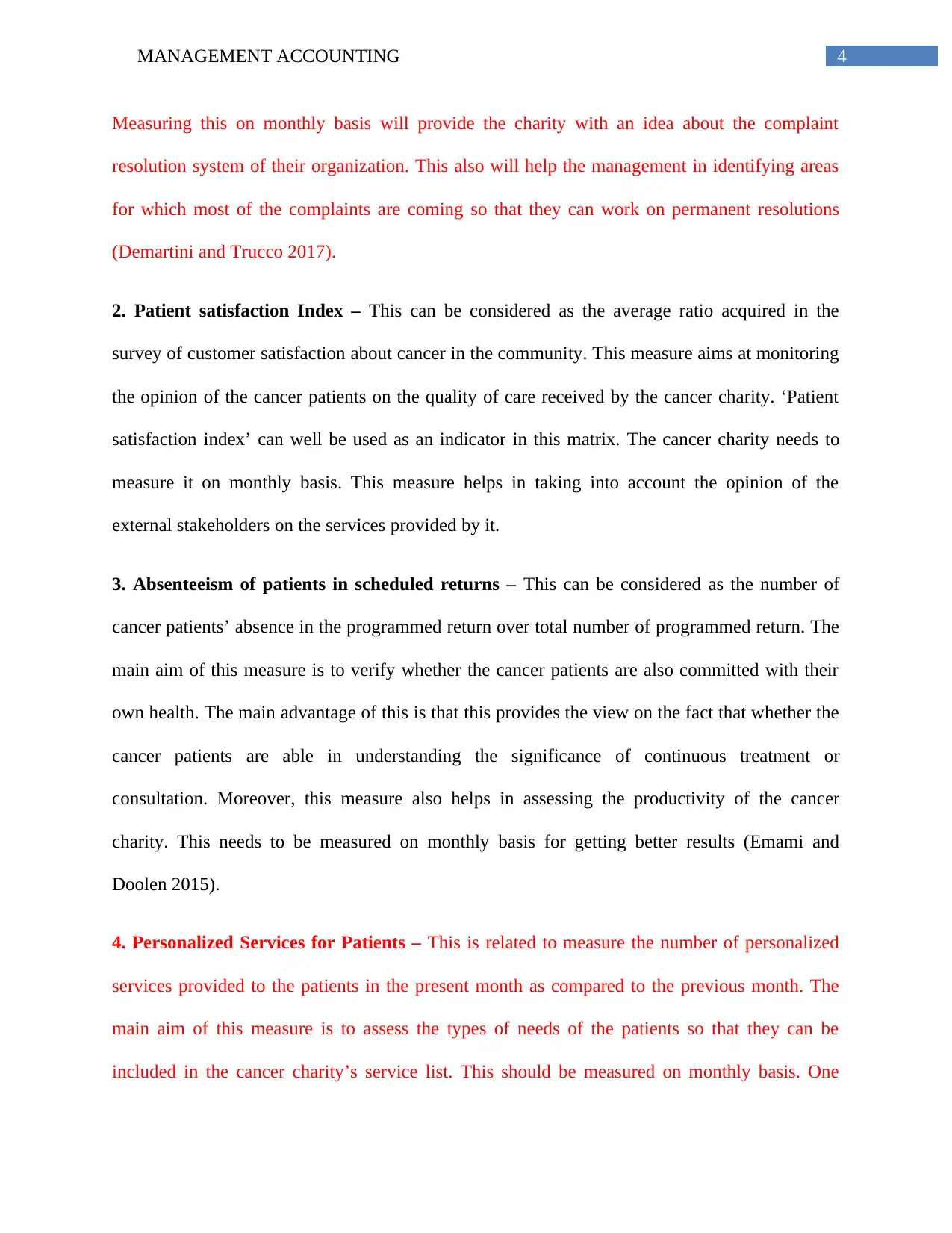
4MANAGEMENT ACCOUNTING
Measuring this on monthly basis will provide the charity with an idea about the complaint
resolution system of their organization. This also will help the management in identifying areas
for which most of the complaints are coming so that they can work on permanent resolutions
(Demartini and Trucco 2017).
2. Patient satisfaction Index – This can be considered as the average ratio acquired in the
survey of customer satisfaction about cancer in the community. This measure aims at monitoring
the opinion of the cancer patients on the quality of care received by the cancer charity. ‘Patient
satisfaction index’ can well be used as an indicator in this matrix. The cancer charity needs to
measure it on monthly basis. This measure helps in taking into account the opinion of the
external stakeholders on the services provided by it.
3. Absenteeism of patients in scheduled returns – This can be considered as the number of
cancer patients’ absence in the programmed return over total number of programmed return. The
main aim of this measure is to verify whether the cancer patients are also committed with their
own health. The main advantage of this is that this provides the view on the fact that whether the
cancer patients are able in understanding the significance of continuous treatment or
consultation. Moreover, this measure also helps in assessing the productivity of the cancer
charity. This needs to be measured on monthly basis for getting better results (Emami and
Doolen 2015).
4. Personalized Services for Patients – This is related to measure the number of personalized
services provided to the patients in the present month as compared to the previous month. The
main aim of this measure is to assess the types of needs of the patients so that they can be
included in the cancer charity’s service list. This should be measured on monthly basis. One
Measuring this on monthly basis will provide the charity with an idea about the complaint
resolution system of their organization. This also will help the management in identifying areas
for which most of the complaints are coming so that they can work on permanent resolutions
(Demartini and Trucco 2017).
2. Patient satisfaction Index – This can be considered as the average ratio acquired in the
survey of customer satisfaction about cancer in the community. This measure aims at monitoring
the opinion of the cancer patients on the quality of care received by the cancer charity. ‘Patient
satisfaction index’ can well be used as an indicator in this matrix. The cancer charity needs to
measure it on monthly basis. This measure helps in taking into account the opinion of the
external stakeholders on the services provided by it.
3. Absenteeism of patients in scheduled returns – This can be considered as the number of
cancer patients’ absence in the programmed return over total number of programmed return. The
main aim of this measure is to verify whether the cancer patients are also committed with their
own health. The main advantage of this is that this provides the view on the fact that whether the
cancer patients are able in understanding the significance of continuous treatment or
consultation. Moreover, this measure also helps in assessing the productivity of the cancer
charity. This needs to be measured on monthly basis for getting better results (Emami and
Doolen 2015).
4. Personalized Services for Patients – This is related to measure the number of personalized
services provided to the patients in the present month as compared to the previous month. The
main aim of this measure is to assess the types of needs of the patients so that they can be
included in the cancer charity’s service list. This should be measured on monthly basis. One
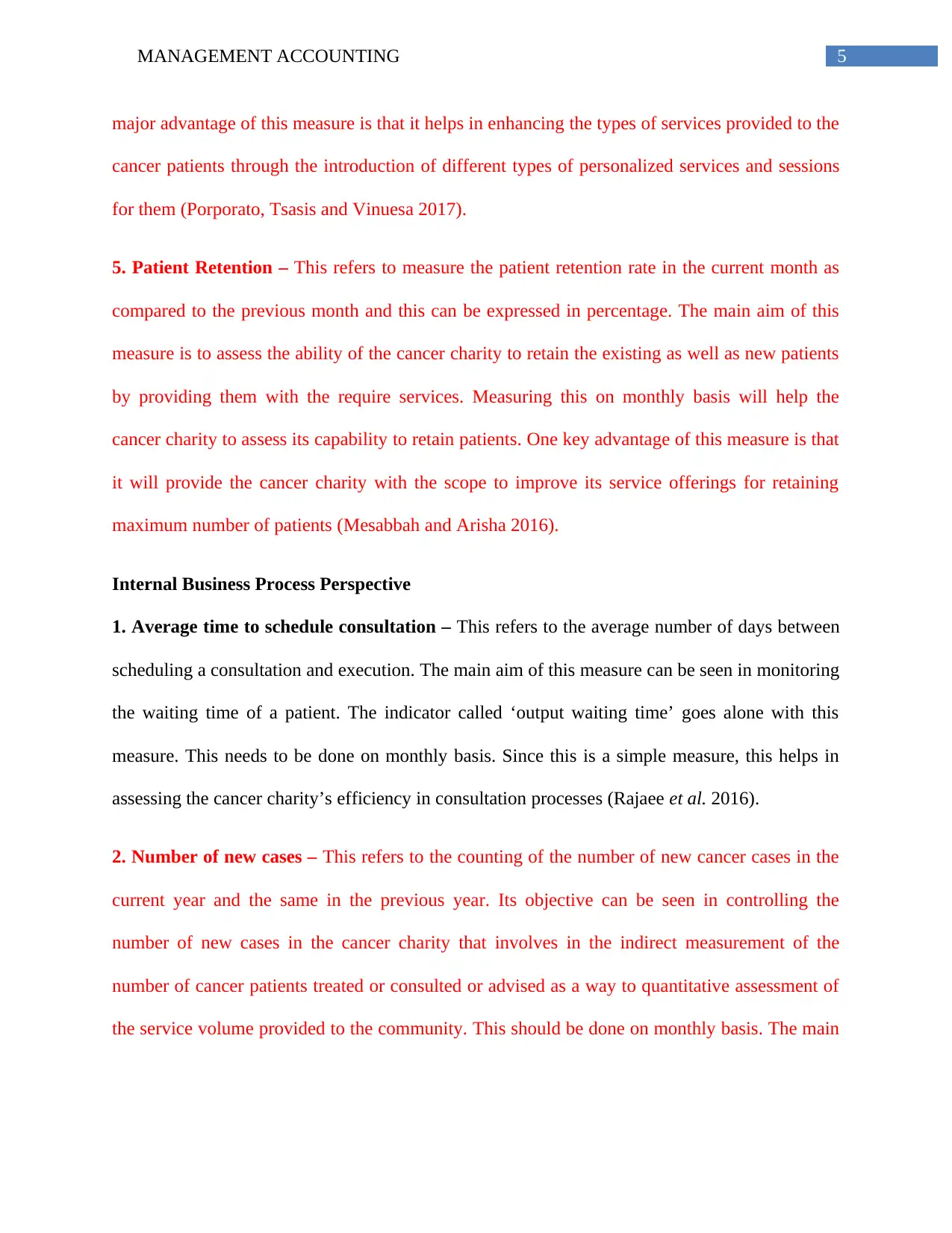
5MANAGEMENT ACCOUNTING
major advantage of this measure is that it helps in enhancing the types of services provided to the
cancer patients through the introduction of different types of personalized services and sessions
for them (Porporato, Tsasis and Vinuesa 2017).
5. Patient Retention – This refers to measure the patient retention rate in the current month as
compared to the previous month and this can be expressed in percentage. The main aim of this
measure is to assess the ability of the cancer charity to retain the existing as well as new patients
by providing them with the require services. Measuring this on monthly basis will help the
cancer charity to assess its capability to retain patients. One key advantage of this measure is that
it will provide the cancer charity with the scope to improve its service offerings for retaining
maximum number of patients (Mesabbah and Arisha 2016).
Internal Business Process Perspective
1. Average time to schedule consultation – This refers to the average number of days between
scheduling a consultation and execution. The main aim of this measure can be seen in monitoring
the waiting time of a patient. The indicator called ‘output waiting time’ goes alone with this
measure. This needs to be done on monthly basis. Since this is a simple measure, this helps in
assessing the cancer charity’s efficiency in consultation processes (Rajaee et al. 2016).
2. Number of new cases – This refers to the counting of the number of new cancer cases in the
current year and the same in the previous year. Its objective can be seen in controlling the
number of new cases in the cancer charity that involves in the indirect measurement of the
number of cancer patients treated or consulted or advised as a way to quantitative assessment of
the service volume provided to the community. This should be done on monthly basis. The main
major advantage of this measure is that it helps in enhancing the types of services provided to the
cancer patients through the introduction of different types of personalized services and sessions
for them (Porporato, Tsasis and Vinuesa 2017).
5. Patient Retention – This refers to measure the patient retention rate in the current month as
compared to the previous month and this can be expressed in percentage. The main aim of this
measure is to assess the ability of the cancer charity to retain the existing as well as new patients
by providing them with the require services. Measuring this on monthly basis will help the
cancer charity to assess its capability to retain patients. One key advantage of this measure is that
it will provide the cancer charity with the scope to improve its service offerings for retaining
maximum number of patients (Mesabbah and Arisha 2016).
Internal Business Process Perspective
1. Average time to schedule consultation – This refers to the average number of days between
scheduling a consultation and execution. The main aim of this measure can be seen in monitoring
the waiting time of a patient. The indicator called ‘output waiting time’ goes alone with this
measure. This needs to be done on monthly basis. Since this is a simple measure, this helps in
assessing the cancer charity’s efficiency in consultation processes (Rajaee et al. 2016).
2. Number of new cases – This refers to the counting of the number of new cancer cases in the
current year and the same in the previous year. Its objective can be seen in controlling the
number of new cases in the cancer charity that involves in the indirect measurement of the
number of cancer patients treated or consulted or advised as a way to quantitative assessment of
the service volume provided to the community. This should be done on monthly basis. The main
⊘ This is a preview!⊘
Do you want full access?
Subscribe today to unlock all pages.

Trusted by 1+ million students worldwide
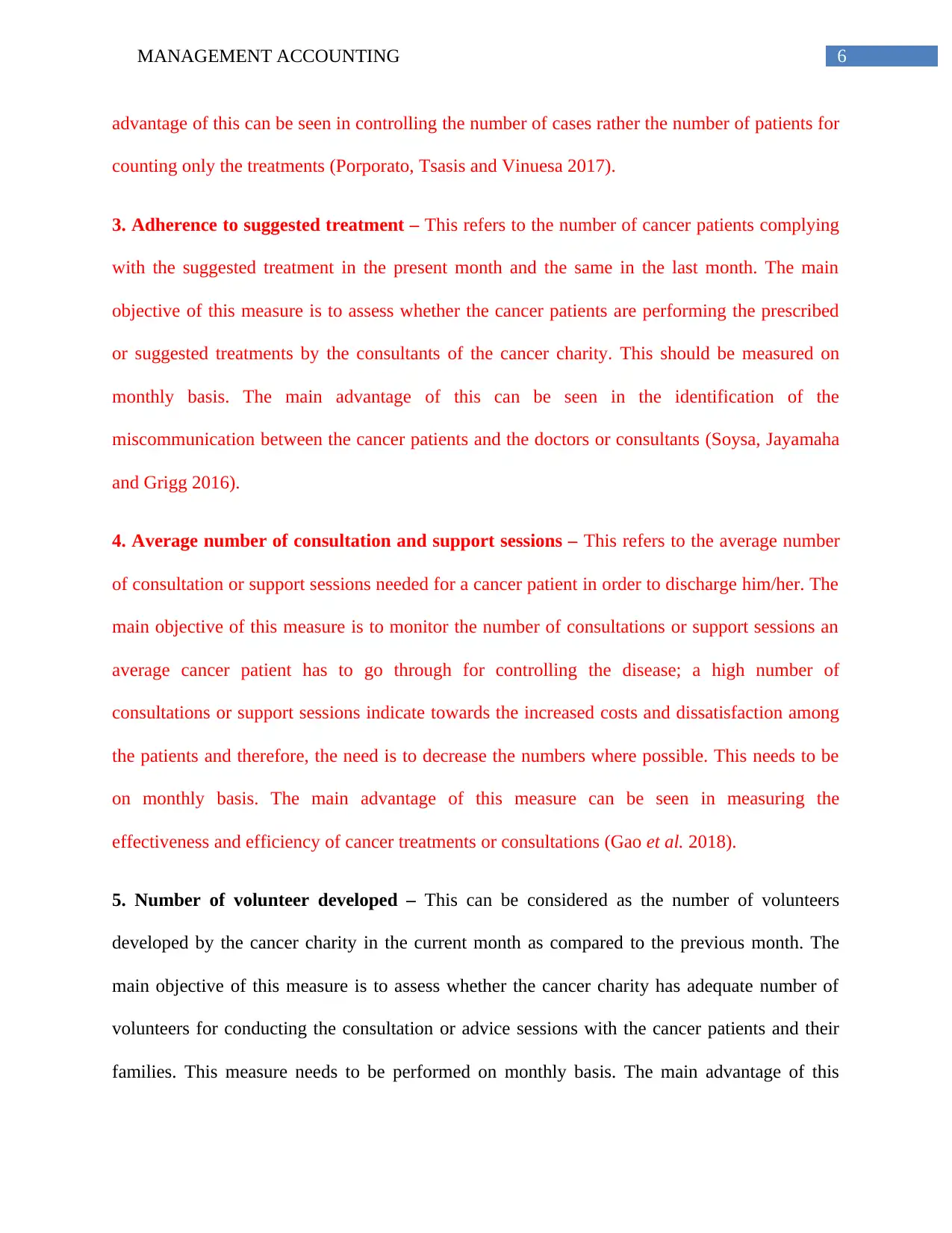
6MANAGEMENT ACCOUNTING
advantage of this can be seen in controlling the number of cases rather the number of patients for
counting only the treatments (Porporato, Tsasis and Vinuesa 2017).
3. Adherence to suggested treatment – This refers to the number of cancer patients complying
with the suggested treatment in the present month and the same in the last month. The main
objective of this measure is to assess whether the cancer patients are performing the prescribed
or suggested treatments by the consultants of the cancer charity. This should be measured on
monthly basis. The main advantage of this can be seen in the identification of the
miscommunication between the cancer patients and the doctors or consultants (Soysa, Jayamaha
and Grigg 2016).
4. Average number of consultation and support sessions – This refers to the average number
of consultation or support sessions needed for a cancer patient in order to discharge him/her. The
main objective of this measure is to monitor the number of consultations or support sessions an
average cancer patient has to go through for controlling the disease; a high number of
consultations or support sessions indicate towards the increased costs and dissatisfaction among
the patients and therefore, the need is to decrease the numbers where possible. This needs to be
on monthly basis. The main advantage of this measure can be seen in measuring the
effectiveness and efficiency of cancer treatments or consultations (Gao et al. 2018).
5. Number of volunteer developed – This can be considered as the number of volunteers
developed by the cancer charity in the current month as compared to the previous month. The
main objective of this measure is to assess whether the cancer charity has adequate number of
volunteers for conducting the consultation or advice sessions with the cancer patients and their
families. This measure needs to be performed on monthly basis. The main advantage of this
advantage of this can be seen in controlling the number of cases rather the number of patients for
counting only the treatments (Porporato, Tsasis and Vinuesa 2017).
3. Adherence to suggested treatment – This refers to the number of cancer patients complying
with the suggested treatment in the present month and the same in the last month. The main
objective of this measure is to assess whether the cancer patients are performing the prescribed
or suggested treatments by the consultants of the cancer charity. This should be measured on
monthly basis. The main advantage of this can be seen in the identification of the
miscommunication between the cancer patients and the doctors or consultants (Soysa, Jayamaha
and Grigg 2016).
4. Average number of consultation and support sessions – This refers to the average number
of consultation or support sessions needed for a cancer patient in order to discharge him/her. The
main objective of this measure is to monitor the number of consultations or support sessions an
average cancer patient has to go through for controlling the disease; a high number of
consultations or support sessions indicate towards the increased costs and dissatisfaction among
the patients and therefore, the need is to decrease the numbers where possible. This needs to be
on monthly basis. The main advantage of this measure can be seen in measuring the
effectiveness and efficiency of cancer treatments or consultations (Gao et al. 2018).
5. Number of volunteer developed – This can be considered as the number of volunteers
developed by the cancer charity in the current month as compared to the previous month. The
main objective of this measure is to assess whether the cancer charity has adequate number of
volunteers for conducting the consultation or advice sessions with the cancer patients and their
families. This measure needs to be performed on monthly basis. The main advantage of this
Paraphrase This Document
Need a fresh take? Get an instant paraphrase of this document with our AI Paraphraser
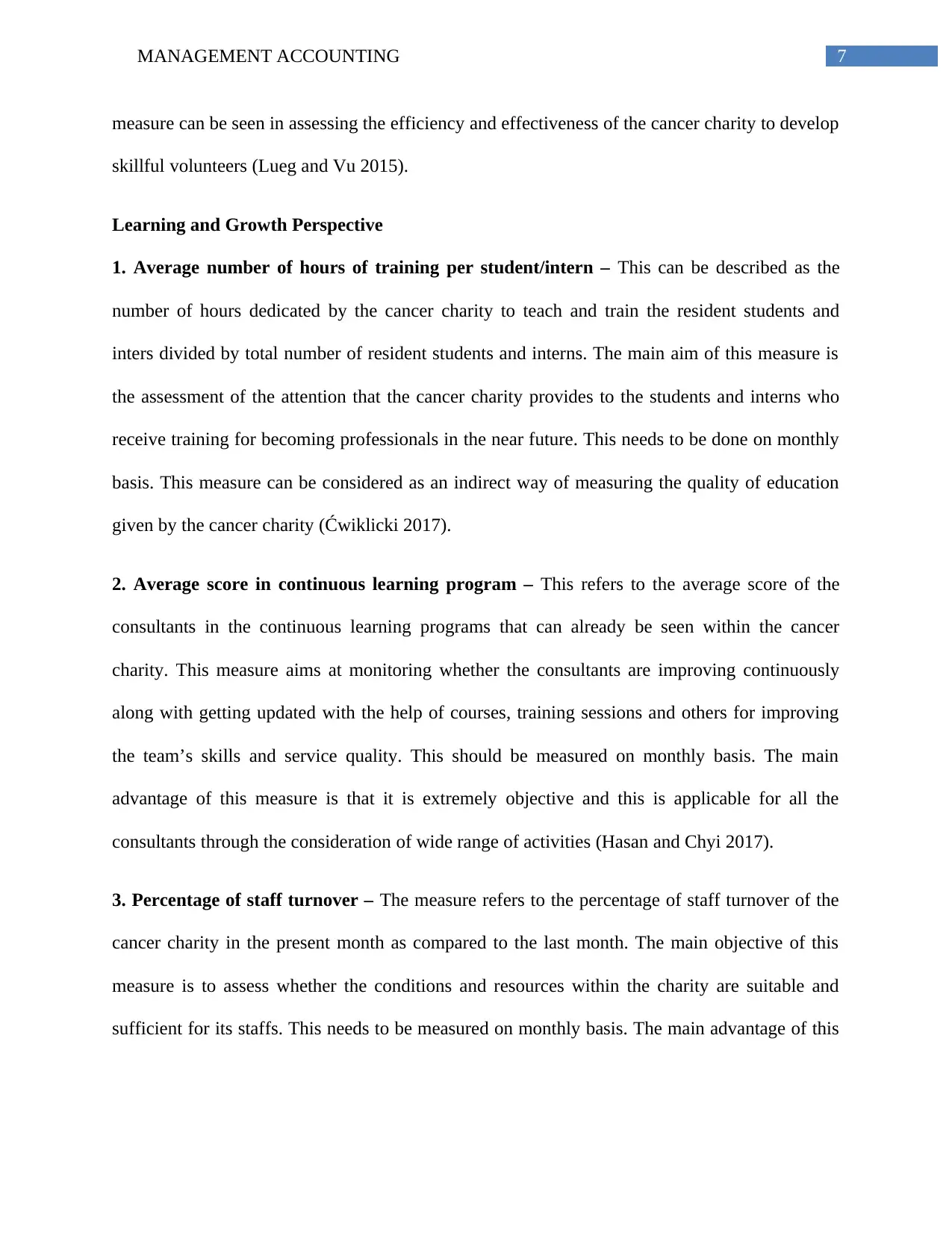
7MANAGEMENT ACCOUNTING
measure can be seen in assessing the efficiency and effectiveness of the cancer charity to develop
skillful volunteers (Lueg and Vu 2015).
Learning and Growth Perspective
1. Average number of hours of training per student/intern – This can be described as the
number of hours dedicated by the cancer charity to teach and train the resident students and
inters divided by total number of resident students and interns. The main aim of this measure is
the assessment of the attention that the cancer charity provides to the students and interns who
receive training for becoming professionals in the near future. This needs to be done on monthly
basis. This measure can be considered as an indirect way of measuring the quality of education
given by the cancer charity (Ćwiklicki 2017).
2. Average score in continuous learning program – This refers to the average score of the
consultants in the continuous learning programs that can already be seen within the cancer
charity. This measure aims at monitoring whether the consultants are improving continuously
along with getting updated with the help of courses, training sessions and others for improving
the team’s skills and service quality. This should be measured on monthly basis. The main
advantage of this measure is that it is extremely objective and this is applicable for all the
consultants through the consideration of wide range of activities (Hasan and Chyi 2017).
3. Percentage of staff turnover – The measure refers to the percentage of staff turnover of the
cancer charity in the present month as compared to the last month. The main objective of this
measure is to assess whether the conditions and resources within the charity are suitable and
sufficient for its staffs. This needs to be measured on monthly basis. The main advantage of this
measure can be seen in assessing the efficiency and effectiveness of the cancer charity to develop
skillful volunteers (Lueg and Vu 2015).
Learning and Growth Perspective
1. Average number of hours of training per student/intern – This can be described as the
number of hours dedicated by the cancer charity to teach and train the resident students and
inters divided by total number of resident students and interns. The main aim of this measure is
the assessment of the attention that the cancer charity provides to the students and interns who
receive training for becoming professionals in the near future. This needs to be done on monthly
basis. This measure can be considered as an indirect way of measuring the quality of education
given by the cancer charity (Ćwiklicki 2017).
2. Average score in continuous learning program – This refers to the average score of the
consultants in the continuous learning programs that can already be seen within the cancer
charity. This measure aims at monitoring whether the consultants are improving continuously
along with getting updated with the help of courses, training sessions and others for improving
the team’s skills and service quality. This should be measured on monthly basis. The main
advantage of this measure is that it is extremely objective and this is applicable for all the
consultants through the consideration of wide range of activities (Hasan and Chyi 2017).
3. Percentage of staff turnover – The measure refers to the percentage of staff turnover of the
cancer charity in the present month as compared to the last month. The main objective of this
measure is to assess whether the conditions and resources within the charity are suitable and
sufficient for its staffs. This needs to be measured on monthly basis. The main advantage of this
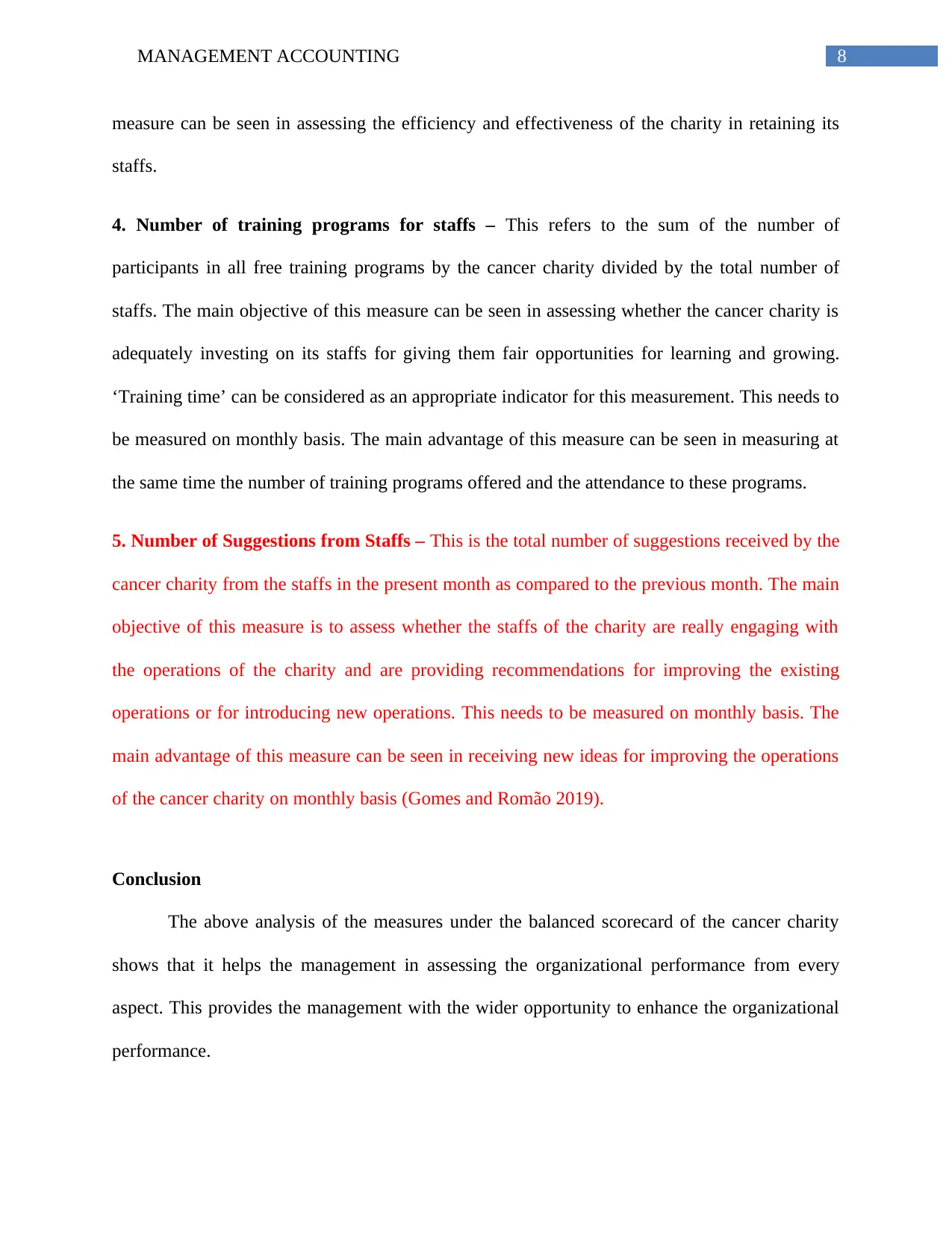
8MANAGEMENT ACCOUNTING
measure can be seen in assessing the efficiency and effectiveness of the charity in retaining its
staffs.
4. Number of training programs for staffs – This refers to the sum of the number of
participants in all free training programs by the cancer charity divided by the total number of
staffs. The main objective of this measure can be seen in assessing whether the cancer charity is
adequately investing on its staffs for giving them fair opportunities for learning and growing.
‘Training time’ can be considered as an appropriate indicator for this measurement. This needs to
be measured on monthly basis. The main advantage of this measure can be seen in measuring at
the same time the number of training programs offered and the attendance to these programs.
5. Number of Suggestions from Staffs – This is the total number of suggestions received by the
cancer charity from the staffs in the present month as compared to the previous month. The main
objective of this measure is to assess whether the staffs of the charity are really engaging with
the operations of the charity and are providing recommendations for improving the existing
operations or for introducing new operations. This needs to be measured on monthly basis. The
main advantage of this measure can be seen in receiving new ideas for improving the operations
of the cancer charity on monthly basis (Gomes and Romão 2019).
Conclusion
The above analysis of the measures under the balanced scorecard of the cancer charity
shows that it helps the management in assessing the organizational performance from every
aspect. This provides the management with the wider opportunity to enhance the organizational
performance.
measure can be seen in assessing the efficiency and effectiveness of the charity in retaining its
staffs.
4. Number of training programs for staffs – This refers to the sum of the number of
participants in all free training programs by the cancer charity divided by the total number of
staffs. The main objective of this measure can be seen in assessing whether the cancer charity is
adequately investing on its staffs for giving them fair opportunities for learning and growing.
‘Training time’ can be considered as an appropriate indicator for this measurement. This needs to
be measured on monthly basis. The main advantage of this measure can be seen in measuring at
the same time the number of training programs offered and the attendance to these programs.
5. Number of Suggestions from Staffs – This is the total number of suggestions received by the
cancer charity from the staffs in the present month as compared to the previous month. The main
objective of this measure is to assess whether the staffs of the charity are really engaging with
the operations of the charity and are providing recommendations for improving the existing
operations or for introducing new operations. This needs to be measured on monthly basis. The
main advantage of this measure can be seen in receiving new ideas for improving the operations
of the cancer charity on monthly basis (Gomes and Romão 2019).
Conclusion
The above analysis of the measures under the balanced scorecard of the cancer charity
shows that it helps the management in assessing the organizational performance from every
aspect. This provides the management with the wider opportunity to enhance the organizational
performance.
⊘ This is a preview!⊘
Do you want full access?
Subscribe today to unlock all pages.

Trusted by 1+ million students worldwide
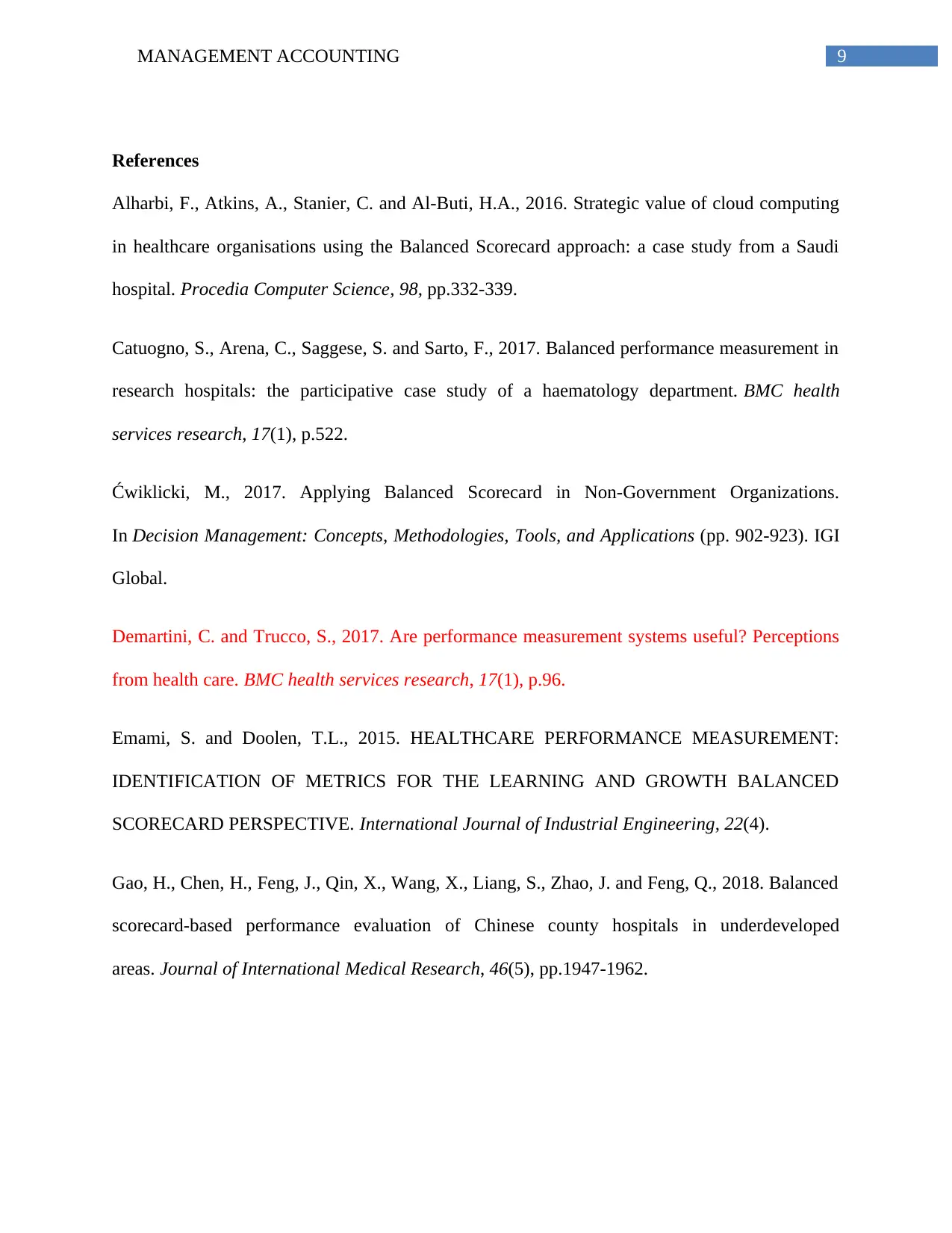
9MANAGEMENT ACCOUNTING
References
Alharbi, F., Atkins, A., Stanier, C. and Al-Buti, H.A., 2016. Strategic value of cloud computing
in healthcare organisations using the Balanced Scorecard approach: a case study from a Saudi
hospital. Procedia Computer Science, 98, pp.332-339.
Catuogno, S., Arena, C., Saggese, S. and Sarto, F., 2017. Balanced performance measurement in
research hospitals: the participative case study of a haematology department. BMC health
services research, 17(1), p.522.
Ćwiklicki, M., 2017. Applying Balanced Scorecard in Non-Government Organizations.
In Decision Management: Concepts, Methodologies, Tools, and Applications (pp. 902-923). IGI
Global.
Demartini, C. and Trucco, S., 2017. Are performance measurement systems useful? Perceptions
from health care. BMC health services research, 17(1), p.96.
Emami, S. and Doolen, T.L., 2015. HEALTHCARE PERFORMANCE MEASUREMENT:
IDENTIFICATION OF METRICS FOR THE LEARNING AND GROWTH BALANCED
SCORECARD PERSPECTIVE. International Journal of Industrial Engineering, 22(4).
Gao, H., Chen, H., Feng, J., Qin, X., Wang, X., Liang, S., Zhao, J. and Feng, Q., 2018. Balanced
scorecard-based performance evaluation of Chinese county hospitals in underdeveloped
areas. Journal of International Medical Research, 46(5), pp.1947-1962.
References
Alharbi, F., Atkins, A., Stanier, C. and Al-Buti, H.A., 2016. Strategic value of cloud computing
in healthcare organisations using the Balanced Scorecard approach: a case study from a Saudi
hospital. Procedia Computer Science, 98, pp.332-339.
Catuogno, S., Arena, C., Saggese, S. and Sarto, F., 2017. Balanced performance measurement in
research hospitals: the participative case study of a haematology department. BMC health
services research, 17(1), p.522.
Ćwiklicki, M., 2017. Applying Balanced Scorecard in Non-Government Organizations.
In Decision Management: Concepts, Methodologies, Tools, and Applications (pp. 902-923). IGI
Global.
Demartini, C. and Trucco, S., 2017. Are performance measurement systems useful? Perceptions
from health care. BMC health services research, 17(1), p.96.
Emami, S. and Doolen, T.L., 2015. HEALTHCARE PERFORMANCE MEASUREMENT:
IDENTIFICATION OF METRICS FOR THE LEARNING AND GROWTH BALANCED
SCORECARD PERSPECTIVE. International Journal of Industrial Engineering, 22(4).
Gao, H., Chen, H., Feng, J., Qin, X., Wang, X., Liang, S., Zhao, J. and Feng, Q., 2018. Balanced
scorecard-based performance evaluation of Chinese county hospitals in underdeveloped
areas. Journal of International Medical Research, 46(5), pp.1947-1962.
Paraphrase This Document
Need a fresh take? Get an instant paraphrase of this document with our AI Paraphraser
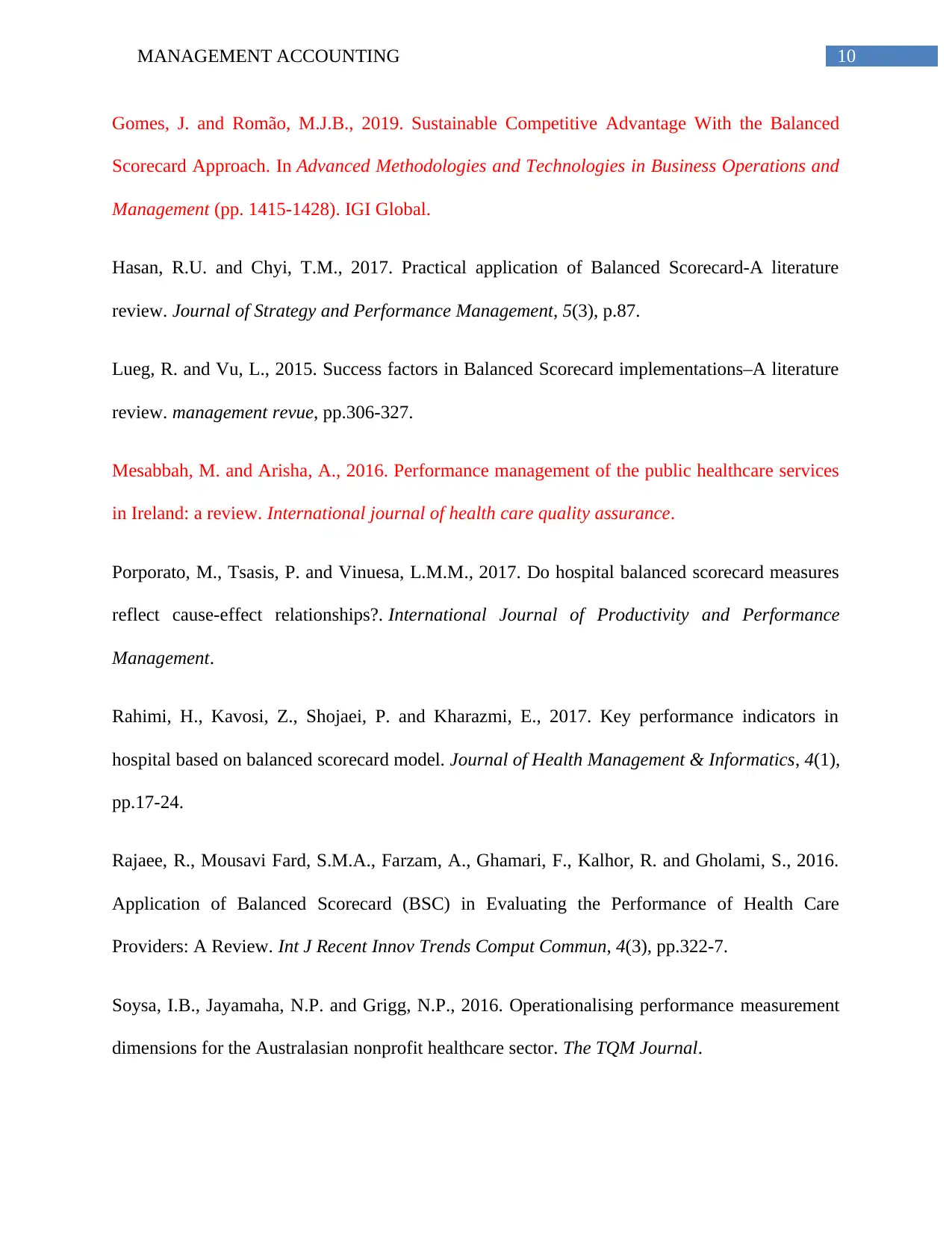
10MANAGEMENT ACCOUNTING
Gomes, J. and Romão, M.J.B., 2019. Sustainable Competitive Advantage With the Balanced
Scorecard Approach. In Advanced Methodologies and Technologies in Business Operations and
Management (pp. 1415-1428). IGI Global.
Hasan, R.U. and Chyi, T.M., 2017. Practical application of Balanced Scorecard-A literature
review. Journal of Strategy and Performance Management, 5(3), p.87.
Lueg, R. and Vu, L., 2015. Success factors in Balanced Scorecard implementations–A literature
review. management revue, pp.306-327.
Mesabbah, M. and Arisha, A., 2016. Performance management of the public healthcare services
in Ireland: a review. International journal of health care quality assurance.
Porporato, M., Tsasis, P. and Vinuesa, L.M.M., 2017. Do hospital balanced scorecard measures
reflect cause-effect relationships?. International Journal of Productivity and Performance
Management.
Rahimi, H., Kavosi, Z., Shojaei, P. and Kharazmi, E., 2017. Key performance indicators in
hospital based on balanced scorecard model. Journal of Health Management & Informatics, 4(1),
pp.17-24.
Rajaee, R., Mousavi Fard, S.M.A., Farzam, A., Ghamari, F., Kalhor, R. and Gholami, S., 2016.
Application of Balanced Scorecard (BSC) in Evaluating the Performance of Health Care
Providers: A Review. Int J Recent Innov Trends Comput Commun, 4(3), pp.322-7.
Soysa, I.B., Jayamaha, N.P. and Grigg, N.P., 2016. Operationalising performance measurement
dimensions for the Australasian nonprofit healthcare sector. The TQM Journal.
Gomes, J. and Romão, M.J.B., 2019. Sustainable Competitive Advantage With the Balanced
Scorecard Approach. In Advanced Methodologies and Technologies in Business Operations and
Management (pp. 1415-1428). IGI Global.
Hasan, R.U. and Chyi, T.M., 2017. Practical application of Balanced Scorecard-A literature
review. Journal of Strategy and Performance Management, 5(3), p.87.
Lueg, R. and Vu, L., 2015. Success factors in Balanced Scorecard implementations–A literature
review. management revue, pp.306-327.
Mesabbah, M. and Arisha, A., 2016. Performance management of the public healthcare services
in Ireland: a review. International journal of health care quality assurance.
Porporato, M., Tsasis, P. and Vinuesa, L.M.M., 2017. Do hospital balanced scorecard measures
reflect cause-effect relationships?. International Journal of Productivity and Performance
Management.
Rahimi, H., Kavosi, Z., Shojaei, P. and Kharazmi, E., 2017. Key performance indicators in
hospital based on balanced scorecard model. Journal of Health Management & Informatics, 4(1),
pp.17-24.
Rajaee, R., Mousavi Fard, S.M.A., Farzam, A., Ghamari, F., Kalhor, R. and Gholami, S., 2016.
Application of Balanced Scorecard (BSC) in Evaluating the Performance of Health Care
Providers: A Review. Int J Recent Innov Trends Comput Commun, 4(3), pp.322-7.
Soysa, I.B., Jayamaha, N.P. and Grigg, N.P., 2016. Operationalising performance measurement
dimensions for the Australasian nonprofit healthcare sector. The TQM Journal.
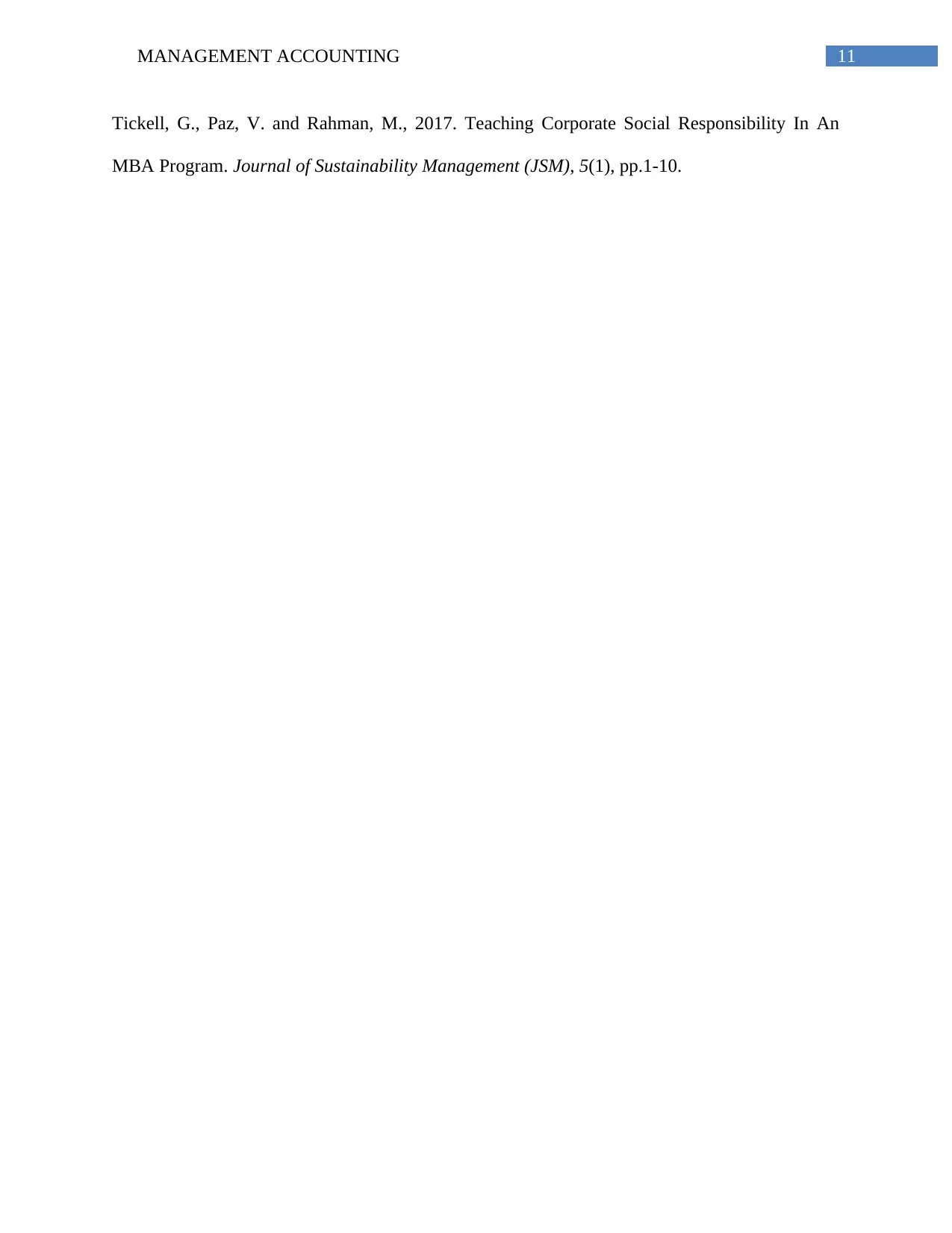
11MANAGEMENT ACCOUNTING
Tickell, G., Paz, V. and Rahman, M., 2017. Teaching Corporate Social Responsibility In An
MBA Program. Journal of Sustainability Management (JSM), 5(1), pp.1-10.
Tickell, G., Paz, V. and Rahman, M., 2017. Teaching Corporate Social Responsibility In An
MBA Program. Journal of Sustainability Management (JSM), 5(1), pp.1-10.
⊘ This is a preview!⊘
Do you want full access?
Subscribe today to unlock all pages.

Trusted by 1+ million students worldwide
1 out of 14
Your All-in-One AI-Powered Toolkit for Academic Success.
+13062052269
info@desklib.com
Available 24*7 on WhatsApp / Email
![[object Object]](/_next/static/media/star-bottom.7253800d.svg)
Unlock your academic potential
Copyright © 2020–2025 A2Z Services. All Rights Reserved. Developed and managed by ZUCOL.


